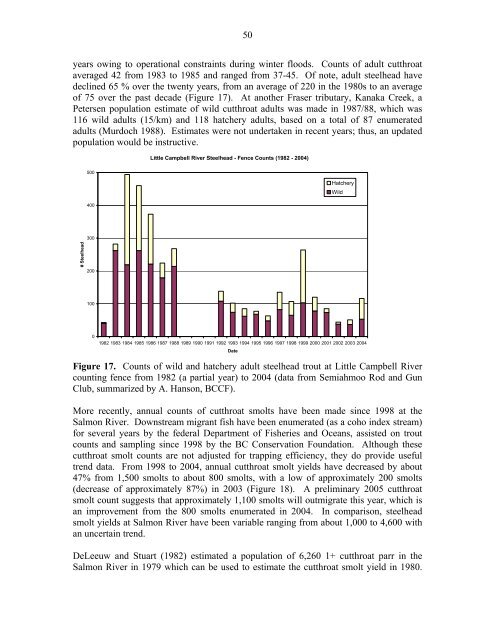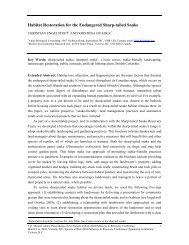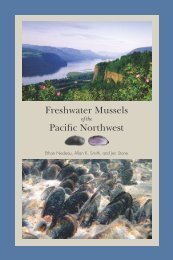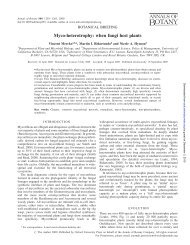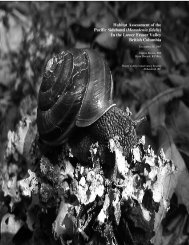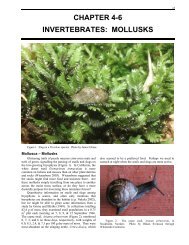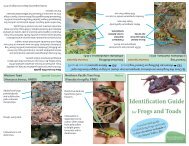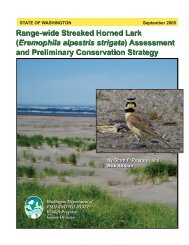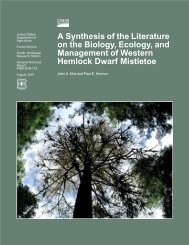Coastal Cutthroat Trout as Sentinels of Lower Mainland Watershed ...
Coastal Cutthroat Trout as Sentinels of Lower Mainland Watershed ...
Coastal Cutthroat Trout as Sentinels of Lower Mainland Watershed ...
Create successful ePaper yourself
Turn your PDF publications into a flip-book with our unique Google optimized e-Paper software.
50years owing to operational constraints during winter floods. Counts <strong>of</strong> adult cutthroataveraged 42 from 1983 to 1985 and ranged from 37-45. Of note, adult steelhead havedeclined 65 % over the twenty years, from an average <strong>of</strong> 220 in the 1980s to an average<strong>of</strong> 75 over the p<strong>as</strong>t decade (Figure 17). At another Fr<strong>as</strong>er tributary, Kanaka Creek, aPetersen population estimate <strong>of</strong> wild cutthroat adults w<strong>as</strong> made in 1987/88, which w<strong>as</strong>116 wild adults (15/km) and 118 hatchery adults, b<strong>as</strong>ed on a total <strong>of</strong> 87 enumeratedadults (Murdoch 1988). Estimates were not undertaken in recent years; thus, an updatedpopulation would be instructive.Little Campbell River Steelhead - Fence Counts (1982 - 2004)500HatcheryWild400300# Steelhead20010001982 1983 1984 1985 1986 1987 1988 1989 1990 1991 1992 1993 1994 1995 1996 1997 1998 1999 2000 2001 2002 2003 2004DateFigure 17. Counts <strong>of</strong> wild and hatchery adult steelhead trout at Little Campbell Rivercounting fence from 1982 (a partial year) to 2004 (data from Semiahmoo Rod and GunClub, summarized by A. Hanson, BCCF).More recently, annual counts <strong>of</strong> cutthroat smolts have been made since 1998 at theSalmon River. Downstream migrant fish have been enumerated (<strong>as</strong> a coho index stream)for several years by the federal Department <strong>of</strong> Fisheries and Oceans, <strong>as</strong>sisted on troutcounts and sampling since 1998 by the BC Conservation Foundation. Although thesecutthroat smolt counts are not adjusted for trapping efficiency, they do provide usefultrend data. From 1998 to 2004, annual cutthroat smolt yields have decre<strong>as</strong>ed by about47% from 1,500 smolts to about 800 smolts, with a low <strong>of</strong> approximately 200 smolts(decre<strong>as</strong>e <strong>of</strong> approximately 87%) in 2003 (Figure 18). A preliminary 2005 cutthroatsmolt count suggests that approximately 1,100 smolts will outmigrate this year, which isan improvement from the 800 smolts enumerated in 2004. In comparison, steelheadsmolt yields at Salmon River have been variable ranging from about 1,000 to 4,600 withan uncertain trend.DeLeeuw and Stuart (1982) estimated a population <strong>of</strong> 6,260 1+ cutthroat parr in theSalmon River in 1979 which can be used to estimate the cutthroat smolt yield in 1980.


